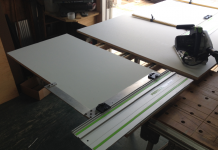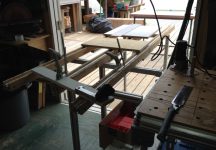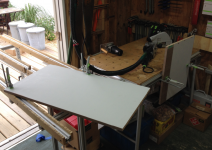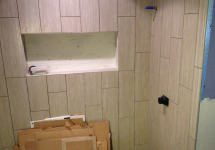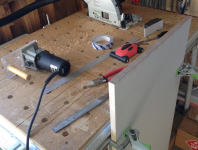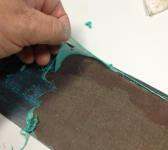Richard/RMW
Member
- Joined
- Jul 11, 2010
- Messages
- 3,063
The boss decided this fall is the time to gut and renovate our guest bath. This is a chance to take my limited cabinet making skills up a notch, and will be followed by the laundry/utility area with lots more cabinets.
The boss has parlayed 20 some years of producing live corporate events, with mega stage sets and lighting, into a business doing interior and exterior design and decorating. She is very talented and our home is a blank canvas for her to experiment with. I am just the semi-skilled labor, mostly in charge of making sure things are plumb, level and don't fall off the walls. She spent the last 2 days researching laminates, etc.
Anyway, I am looking for suggestions on the best work flow/approach to applying laminate to the faces and edge of prefinished (1 side) maple ply for the boxes, and unfinished ply for doors, drawers. She wants a very contemporary look.
I will probably use this as an excuse to buy a MFK 700 to handle trimming.
I think I will just use a water based contact cement, but my only experience is with the Home Depot stuff so please chime in with suggestions.
In the example of a drawer front or door, is the best method to laminate the front & rear, trim them and then apply the edges 2 at a time, sides the trim, followed by top/bottom and trim?
Any suggestions would be welcomed.
RMW
The boss has parlayed 20 some years of producing live corporate events, with mega stage sets and lighting, into a business doing interior and exterior design and decorating. She is very talented and our home is a blank canvas for her to experiment with. I am just the semi-skilled labor, mostly in charge of making sure things are plumb, level and don't fall off the walls. She spent the last 2 days researching laminates, etc.
Anyway, I am looking for suggestions on the best work flow/approach to applying laminate to the faces and edge of prefinished (1 side) maple ply for the boxes, and unfinished ply for doors, drawers. She wants a very contemporary look.
I will probably use this as an excuse to buy a MFK 700 to handle trimming.
I think I will just use a water based contact cement, but my only experience is with the Home Depot stuff so please chime in with suggestions.
In the example of a drawer front or door, is the best method to laminate the front & rear, trim them and then apply the edges 2 at a time, sides the trim, followed by top/bottom and trim?
Any suggestions would be welcomed.
RMW

![ScreenClip [7].png](/data/attachments/1/1662-ece3daf217e90705186dbb441827d108.jpg?hash=8qMi9WMTFf)
![ScreenClip [3].png](/data/attachments/1/1663-3e6c2c2ea8259a5bb623fe1fe52dcc96.jpg?hash=gHXkFk-Lby)
![ScreenClip [5].png](/data/attachments/1/1664-dec5b0218cfde71ae584a08130a56c1f.jpg?hash=-0sTMB3rEz)
![ScreenClip [6].png](/data/attachments/1/1665-f2fe6f0c8ca50d2a7b1e7e0d2d598fd1.jpg?hash=nbmHP7834b)

